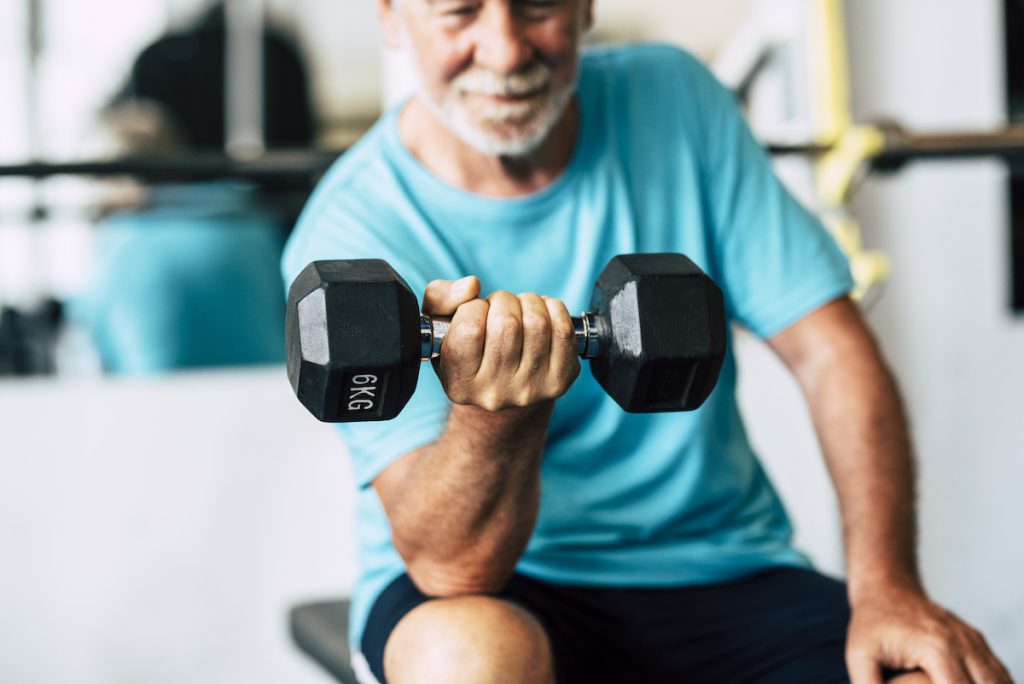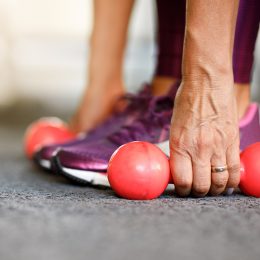What’s the Minimum Amount You Can Strength Train and Still See Results?
Experts explain — and offer tips for making your workouts extra effective.

When it comes to exercise, cardio tends to get all the love. You enjoy a refreshing swim, a bike ride, or a walk with a friend. And — like many people — you might be less psyched about strength training.
That’s OK. Because there’s good news: While resistance training is important for staying strong and healthy, research shows that you can get plenty of benefits by getting even a small amount of it.
A position statement from the National Strength and Conditioning Association, for example, notes that just one session a week can lead to significant increases in strength and muscle mass in older adults.
Here’s why you should make strength training a priority — whether it’s one workout a week or more. Plus, we’ve got expert tips for making the most of each session.
Get and stay fit with SilverSneakers! Choose from dozens of different Community classes, visit a participating fitness location, or view the current schedule of SilverSneakers LIVE online classes.
The Benefits of Strength Training for Older Adults
Strength exercises like lifting dumbbells or doing moves that use your own body weight, such as push-ups and planks, offer a lot of compelling benefits, especially for older adults, according to the National Institute on Aging and the American Council on Exercise.
They include:
- Maintaining muscle mass
- Reducing frailty and fall risk
- Increasing mobility
- Preserving bone density
- Boosting quality of life
- Reducing the risk of chronic diseases like arthritis, heart disease, type 2 diabetes
- Improving sleep quality
- Lowering depression and anxiety risk
- Supporting brain health and cognitive function
Because of these perks, many studies suggest that strength training may also have a major role in helping you live longer.
SilverSneakers Classic is a great way to build strength and endurance in a supportive atmosphere. Classes are offered both in-person at participating fitness locations and online with SilverSneakers LIVE.
What’s the Minimum Amount of Strength Training You Personally Need?
When it comes to strength training, the key word is training, according to Tom Hogarty, M.S., C.E.P., an exercise physiologist at Tallahassee Orthopedic and Sports Physical Therapy.
“The goal of strength training is not to do exercises just for the sake of doing them, but to have them actually translate to everyday life. That means improving the way your body functions and, ultimately, your quality of life,” he says.
Hogarty says that the minimum amount you need depends on how fit you are already. One session per week — as little as 15 minutes of lifting weights in some cases — might be plenty for you if you haven’t been doing any strength training.
But an active 75-year-old who has been training for years would likely find that they need to do two or three days of strength training to continue seeing results, says Hogarty.
“Don’t be discouraged or think you’re behind if you’re only doing one session a week,” adds Ryan Glatt, C.P.T., a personal trainer at Providence Saint John’s Health Center in Santa Monica, California. “You can actually become very fit if you use that time wisely.”
Top Strength Training Tips for Older Adults
No matter what your minimum is, there are some strength-training pointers that apply to everyone. Try these strategies to make your training time more efficient:
Do compound exercises. These are strength moves that target many muscle groups at the same time. For example, you could do squats combined with an overhead press. Exercises like these can be a great way to increase overall functional strength and get more accomplished in less time, Glatt says.
Press play to try for yourself:
Recommended workout: 5-Move Functional Workout to Help You Stay Independent Longer
Warm up properly. Do some light cardio and stretching to get your muscles ready to work. Glatt notes that this will also activate your neuromuscular system, so your brain is prepped for training just as much as your body.
Recommended warmup: 7 Quick Moves to Do Before Every Strength Workout
Think beyond dumbbells. You don’t have to lift weights to do strength training. Instead, think about what will provide a meaningful amount of resistance to challenge your muscles. That could be your own bodyweight, a half- to full-gallon water bottle, or grabbing a resistance band when you’re at the gym.
Subscribe to our newsletter
It's quick and easy. You could be one of the 13 million people who are eligible.
Already a member? Click to discover our 15,000+ participating locations.
Follow Us
For example, doing exercises like triceps dips and lunges where you’re lifting your own body weight will give you the meaningful amount of resistance that will deliver results.
“You want enough load that doing more than 15 repetitions would be challenging,” he says. All while keeping proper form, of course.
Recommended workout: 5 Bodyweight Moves That Work Nearly Every Muscle in Your Body
Change things up over time. “The body needs new stimulus, which is not necessarily about intensity as much as it’s about novelty,” Hogarty says. “That’s how to make progress.”
In order to maximize results and minimize plateaus, you have two options:
- Up the number of repetitions you do every three to four weeks. If you’re currently doing 8 reps, for example, take it up to 10, then 12, then 15.
- Up the amount of weight or resistance. At some point, it’s no longer practical to keep tacking on more reps. Instead, increase the amount of weight in small increments.
Recommended reading: How to Add More “Weight” to Your Favorite Exercises (Without Ever Buying New Equipment)
What you’ll begin to find is that your personal “minimum” will change as your body adapts to strength training, Glatt adds. That’s a good thing, because it means you’re getting stronger, supporting your joints, and reaping the benefits of this type of exercise.
Take Your Favorite SilverSneakers Classes Online!
SilverSneakers members can access live fitness classes and wellness workshops through SilverSneakers LIVE. See the latest schedule and RSVP for classes here.
Not a member? If you have a Medicare Plan, it may include SilverSneakers—at no additional cost. Check your eligibility instantly here.
Not eligible for SilverSneakers? You can still get 200+ free SilverSneakers On-Demand videos and stay in touch with us by creating your online account.





